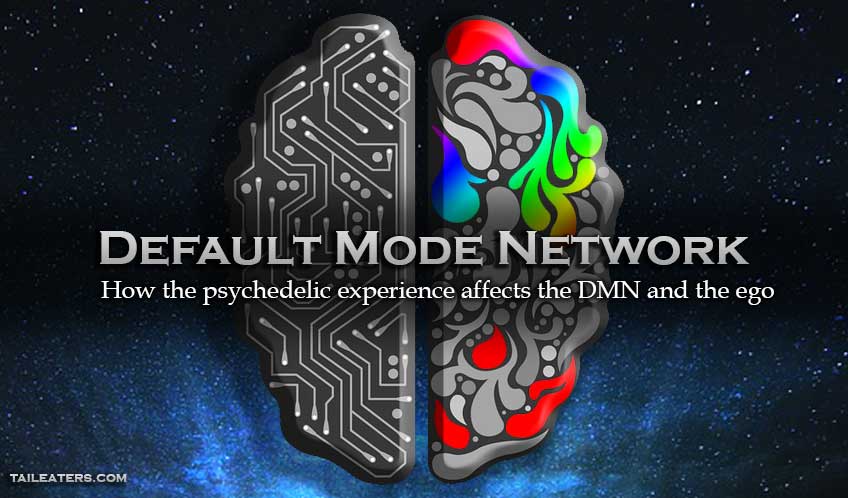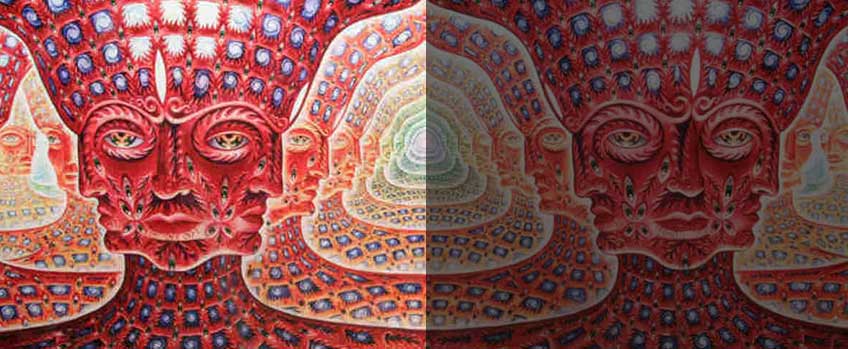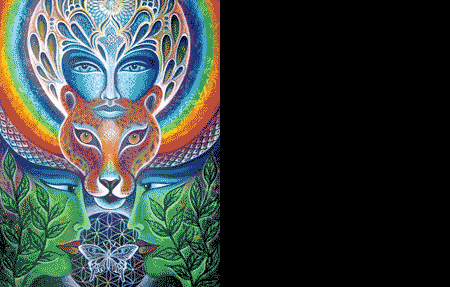
Default Mode Network
How Psychedelics Change Our Minds
Whenever new research comes out about something in the mass medias eyes that is “exciting” or “unique,” people start to spread these concepts with almost religious-like zeal. Scientific terms become buzz words which often end up being used in conjunction with ideas or hypothesis that have no relationship to the original idea. Recently a great example of this is in quantum physics where no one fully understands what quantum means and everyone uses it to explain mystical or psychedelic experiences. Another term which has become the buzzword of recent overuse is the Default Mode Network in relationship to psychedelics.
Psychonauts have recently started to use the process of the Default Mode Network shutting down as a phenomenon that is limited to the psychedelic experience. The Default Mode Network is not some aspect of the human consciousness that is limited to the psychedelic experience. Researches have known about the Default Mode Network for some time and have been observing modulation of the network through many forms of altered states including meditation, hypnosis, and sleep.
The Default Mode Network is a representation of the brain in normal default working condition. It’s as simple as that. If you look at the effects that take place from this default mode network being active, you see that this corresponds significantly to the description that many people give the working ego.
Ego Death and the Default Mode Network
In the article: The Brain’s Default Network and its Adaptive Role in Internal Mentation, the authors explore what the Default Mode Network and what this network is providing humans in its normal working condition. They said that it allows for a neurological overview for the self (ego). It also provides a way for us to explore thoughts of others and what others may or may not know. It also provides a memory of the past and how to imagine the future. This default mode is what we experience every waking day as we explore and learn about our environment and how we fit into that. Without this default mode, we would be unable to function in normal society. Obviously, there is some evolutionary importance to the Default Mode Network as it provides us the ability to remember, to understand our own thoughts in comparison to others, and express empathy. All which are evolutionary essential for our survival as a species.
When someone experiences “ego death” from psychedelics, we find the opposite effects take place. We hear about people becoming one with the universe, a loss of self, social constructs become unimportant or questionable, and time and memory of events become equally trivial. It would make sense that the Default Mode Network was recently discovered as the primary way that psychedelics are affecting the human experience during a psychedelic trip. Not all psychedelics are created equally either, as cannabis increases Default Mode Network activation.
Default Mode Network Effects in Sleep and Disease
Shutting down the Default Mode Network is not limited to the use of psychedelics. In the debilitating effects of Alzheimer’s, we find evidence of the breakdown of the Default Mode Network much like a psychedelic trip. As the disease continues to grasp onto the individuals, their memory deteriorates, their sense of self slowly dissolves, and they also experience extreme hallucinations which can also be very debilitating. Studies have shown that what is happening for Alzheimer’s patients, is that the Default Mode Network is slowly deteriorating. Unlike the psychedelic experience, the individual suffering with Alzheimer’s is not able to recover their Default Mode Network and slowly continues to experience higher levels of ego dissolution up until death. Logically, medications which combat Alzheimer’s disease such as Galantamine improves the operation of the Default Mode Network over time. These same medication also are beneficial in altered dream states such as lucid dreaming and Out of Body Experiences. With brings my interest into finding out Galantamine’s relationship to the Default Mode Network in correlation to dream states.
Default Mode Network modulation is also related to sleep and dreams, specifically in NREM states of sleep which accounts for hypnagogia which can include psychedelic visuals and auditory like hallucinations. Researchers have been investigating the modulation of the Default Mode Network during sleep and have begun to understand that the Default Mode Network shutting down is a key component of sleep cycles. Specifically, the modulation of the Default Mode Network in the prefrontal cortex seems to be an instrumental part of why we dream. Unlike the psychedelic experience which can last for hours, the experience during sleep continues for only moments which could account for the short lasting effects described in Out of Body Experiences or hypnagogia. Additionally, this modulation of the Default Mode Network happens in average around five times a night for each individual as we come in and out of REM sleep. This makes Default Mode Network modulation commonplace in the human experience.
The profoundness in the psychedelic experience seems to relate to the amount of time that the Default Mode Network is able to shut down temporarily. The modulation of the Default Mode Network is not only being affected by the psychedelic experience but surprisingly there is also a large decrease in brain activity in specific areas of the brain which is not rerouted into other regions, it is dissipated. This loss of control of the Default Mode Network seems to bring up the psychedelic or dream-like experience which is always happening under the guise of the ego. Esotericist P. D. Ouspensky believed this to be true. Osha the philosophic leader of the Rajneeshpuram agreed by saying, ” You are constantly dreaming – not only in the night, not only while you are asleep; you are dreaming the whole day.” If we consider hypnotic active imagination which takes place during meditation or daydreaming, it becomes pretty obvious that when the mind is quite, hallucinatory like images began to arise.
There are of course exceptions to the long-lasting effects as some psychedelics are short lasting such as pure DMT can last for upwards to 30 min, unlike psilocybin and Ayahuasca which can last hours. These experiences may be inspiring and change the individual because of the profoundness of the experience itself, rather than what is learned.
What is Being Learned?
Personal experience with the psychedelic experience, my lucid dream, and Out of Body Experience, and my personal and academic research into Jungian psychology have provided me a unique look into the wholeness that is expressed in an altered state. When it comes to the psychedelic experience, an impulse towards wholeness seems to be the overarching goal. Psychonauts often imply that “ego death” and merging with the universe is generally a good thing and should be sought after. Those who do report their psychedelic experiences seem to be describing through sensations or their psychological state of mind varying degrees of the Default Mode Network modulation, the loss of self is one such degree.
The Default Mode Network appears to allow the control mechanism of the human consciousness to temporarily shut down, allowing for the underlying archetypes that develop the human unconscious to express themselves in varying ways with the ultimate goal of unity or as Jung described as the syzygy. This communication seems to act as a temporary mediation between the more dominate archetypes that express themselves clearly in the form of spiritual hallucinations and spiritual symbology. Its no wonder why many people express the psychedelic experience as “ten years of therapy completed in a few hours.”
As stated before the relationship of the psychedelic experience to dreams is uncanny. The same symbols, words, and themes are expressed in the complexities of our dreams which are often overlooked as noise. The dramatic shutdown of the Default Mode Network in the psychedelic experience makes us more attentive to these experiences as they feel and seem more real. This same spectacular experience is also expressed in those who have had Out of Body Experiences or Near Death Experiences, both being equally dramatic and real or described as “more real than real.”
As both Jung and Freud saw dream symbology as a representation of the individual’s underlying desires and used dream analysis to do so, we are equally capable of using Jungian dream analysis to look at the language and symbology that represents the psychedelic experience to understand the human psyche. In doing so, we can start to see essential themes arise out of the experience itself understanding not only more about the overall commonalities of the human psyche but also what individualism resides in each of us.
Psychedelic Artwork
We see archetypal themes very blatantly represented in most psychedelic artwork which is a direct representation of the psychedelic experience. Viewing the artwork you can see that it is mainly an artistic rendition of symmetry. It also often depicts a person where the right and left side of the person are almost perfect reflections of each other. The unity or symmetry in the theme of the artwork shows what happens when the Default Mode Network temporarily shuts down, it’s providing a bridge of communication between both dualities of the human psyche.

Artistic representation of the DMT experience. Left and right sides of the art are repeating.

Here we can see the original painting which was done by hand on the left. I have used a computer to cut the image in half and used two true right sections to create a complete left and right image. We can see the result is almost exactly the same. This is a continuing theme through most psychedelic artwork.
Descriptions of the Experience
In the explanations provided by those who take part in psychedelic describe spirits or beings which act in masculine or feministic nature, i.e., Ayahuasca mother, Jesus, Buddha, etc. Through Jungian dream analysis, we find that these representations are again the male and female aspects of human consciousness.
The description of the experience extends past the opposing forces found in the human psyche as the unity of these two archetypes is also expressed in reports of the psychedelic experience. In words used by those who have profound psychedelic experiences they frequently describe the unity that they feel with the universe, the dissolving of the dualities, merging with the divine, and destroying the ego. Unity experiences, however, are not as common as those who experience duality experiences in the altered state as discussed by Dr. Rich Strassman in his book DMT: The Spirit Molecule. It is still my view that unity of the human consciousness is the ultimate desire of the psychonaut and why its discussed so often as the ultimate goal. As almost an addictive desire for the human experience, unity through the shutting down of the Default Mode Network seems to be the driving force behind the language and symbols expressed in the psychedelic experience.
The Effects of Default Mode Network Modulation
Temporary modulation or the changing of degrees of the Default Mode Network’s dominance over the human psyche provides changes in perception and personality. As discussed before, throughout our day our Default Mode Network changes in degrees of what specific areas of our brain are activated or deactivated, especially in sleep. This modulation of the Default Mode Network brings with it altered states (altered Default Mode Network) experiences. Not surprising hypnosis also falls in line with temporarily shutting down the Default Mode Network. Most studies conducted on therapeutic uses of temporarily shutting down the Default Mode Network are focused on meditation practices or reprograming beliefs through hypnosis which is both less dramatic than psychedelics but still provide some modulation. Changes can be seen to take place improving the overall individuals perspective when used in conjunction with other therapeutic techniques. Even in conative debilitating diseases, Default Mode Network modulation has shown to improve cognitive function.
It would seem that the Default Mode Network temporary shutting down is somehow allowing not only individuals to “change their minds” but also after returning to homeostasis, the mind is more resilient to stress and more aware of itself. Unlike what psychonauts would like to think about the psychedelic trip destroying the ego, it would seem that the effects of the trip itself are somehow strengthening the Default Mode Network or increasing the ego itself. We can see this happening with resilience training, meditation work, Alzheimer’s medication, all of which disengage the Default Mode Network in varying degrees, and allow the brain to return to homeostasis. If the psychedelic experience provides a profound or extreme disengagement of the Default Mode Network, it’s not a huge jump in logic to assume that it would also produce similar results to the ego.
In light of this information, we need to change our perspective of the ego as a negative entity of our psyche. The ego more closely relates to how we perceive reality rather than our overly aggressive sense of self. Judgment falls on each of our own egos based on what our underlying archetypal beliefs are, the ego is just the messenger of these beliefs. Culture and morality determine if these beliefs are right and wrong. Though there are still some universal commonalities in morality in the human experience as Jung said in relation to sexual abstinence, “…mankind must obviously have had very strong reasons for devising this morality, for otherwise, it would be truly incomprehensible why such restraints would be imposed on one man’s strongest desires.” If morality is an expression of the human psyche, and that human psyche is an evolved expression of nature, then morality has some universal truth to its development. The desire to alter our consciousness and to experience the synchronicity through the psychedelic experience is equality universal.
The Good and Bad
What is done during the psychedelic experience while the Default Mode Network offline seems to be a determining component as to how the ego is effected. Psychedelics in this way act as a powerful form of hypnosis, allowing the individual to not only become highly suggestible to change but also form a dialog internally with the goal of unconscious homeostasis. This does not mean that shutting down the Default Mode Network is inherently good or bad. It would depend on your beliefs, and your level of morality and cultural views to determine if you deteriorated into a deeper form of narcissism after the mind returns to normal. Using the Default Mode Network as a tool you could realign your ego to become more extreme or you could choose to be more centered and hopefully be a more whole person.
Lee Adams is a Ph.D. candidate in Jungian Psychology and Archetypal Studies at Pacifica Graduate Institute and host of Cosmic Echo, a lucid dreaming podcast, and creator of taileaters.com, an online community of lucid dreamers and psychonauts. Lee has been actively researching, practicing, and teaching lucid dreaming for over twenty years.
Join the Discussion
Want to discuss more about this topic and much more? Join our discussion group online and start exploring your consciousness with others like yourself.



I like what you write. Would be nice to see citations.
Thanks Scott. Most of the links are citations that you should be able to click on and view.